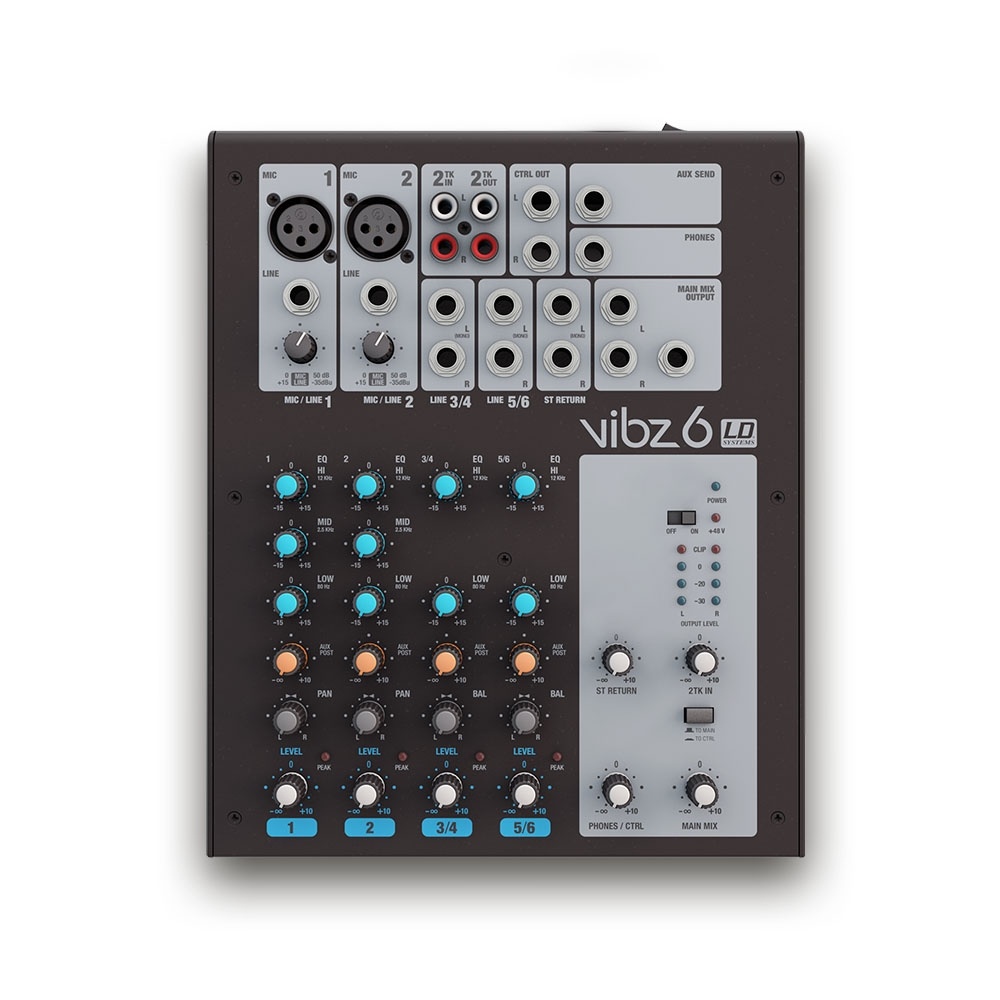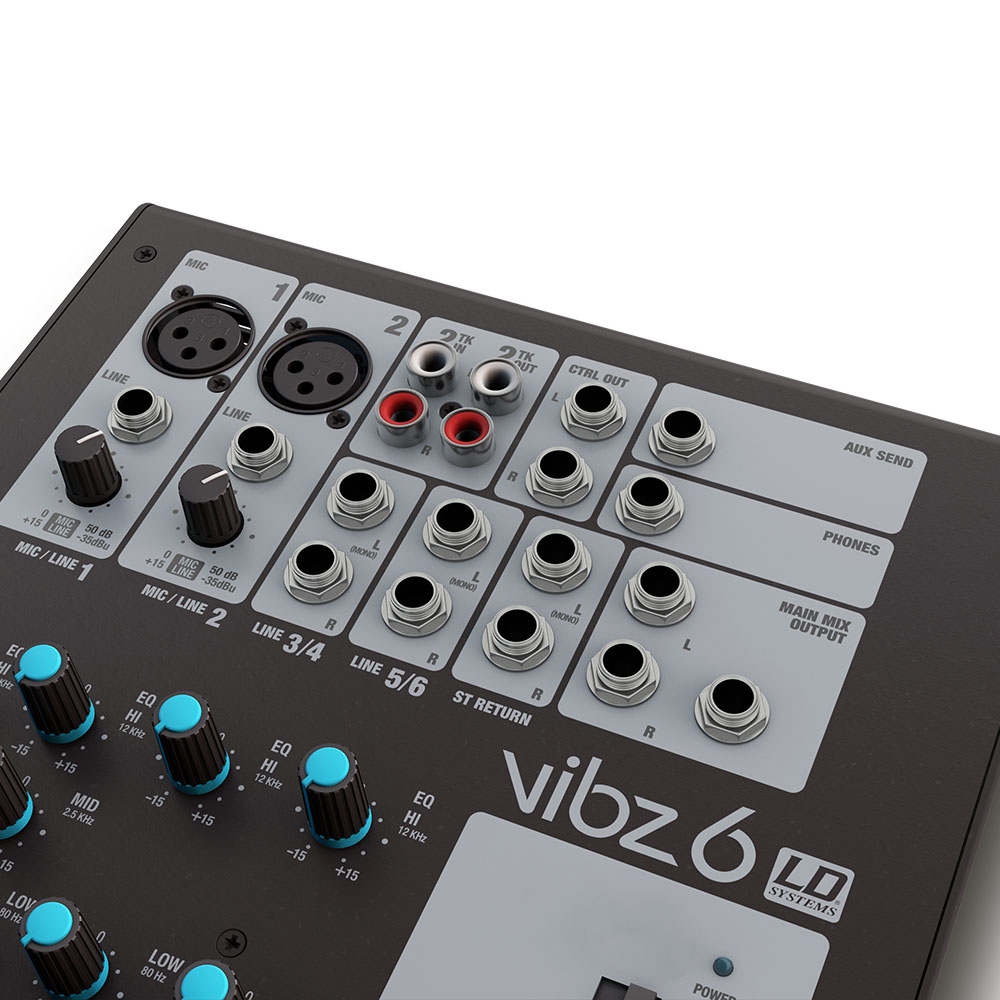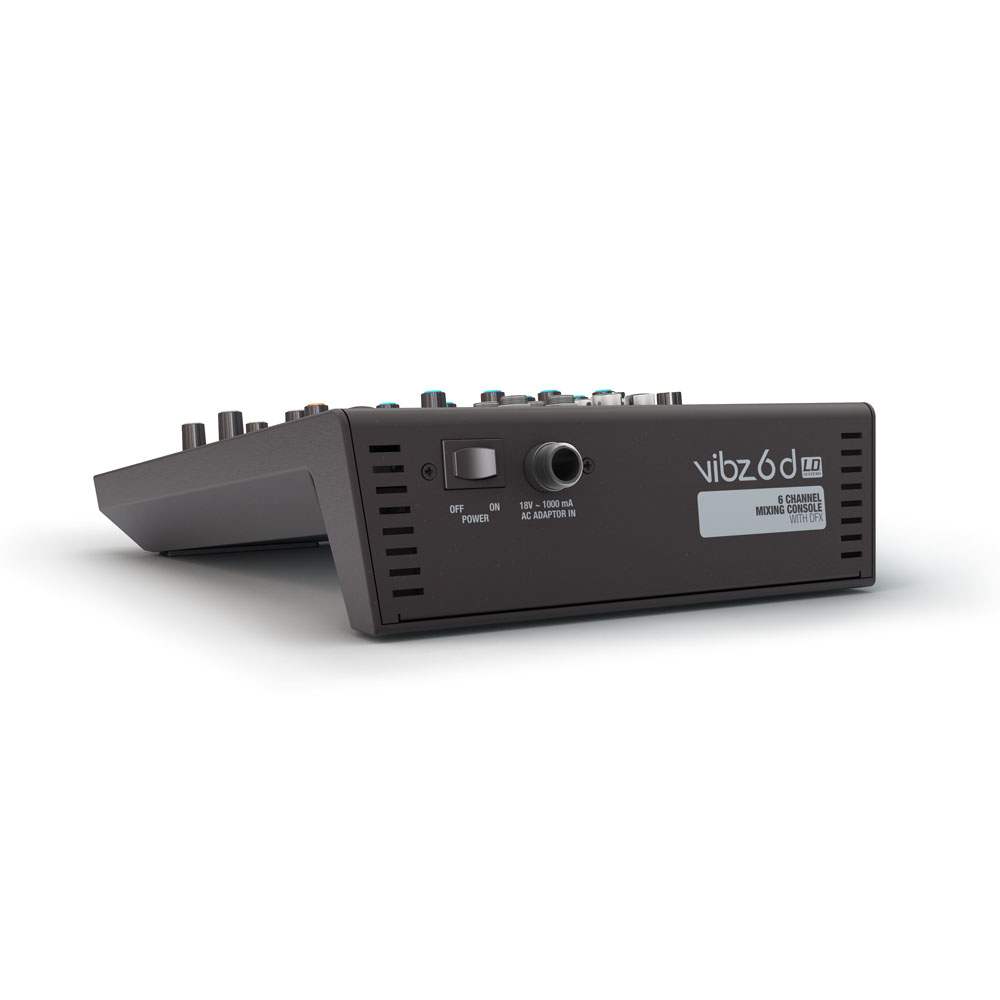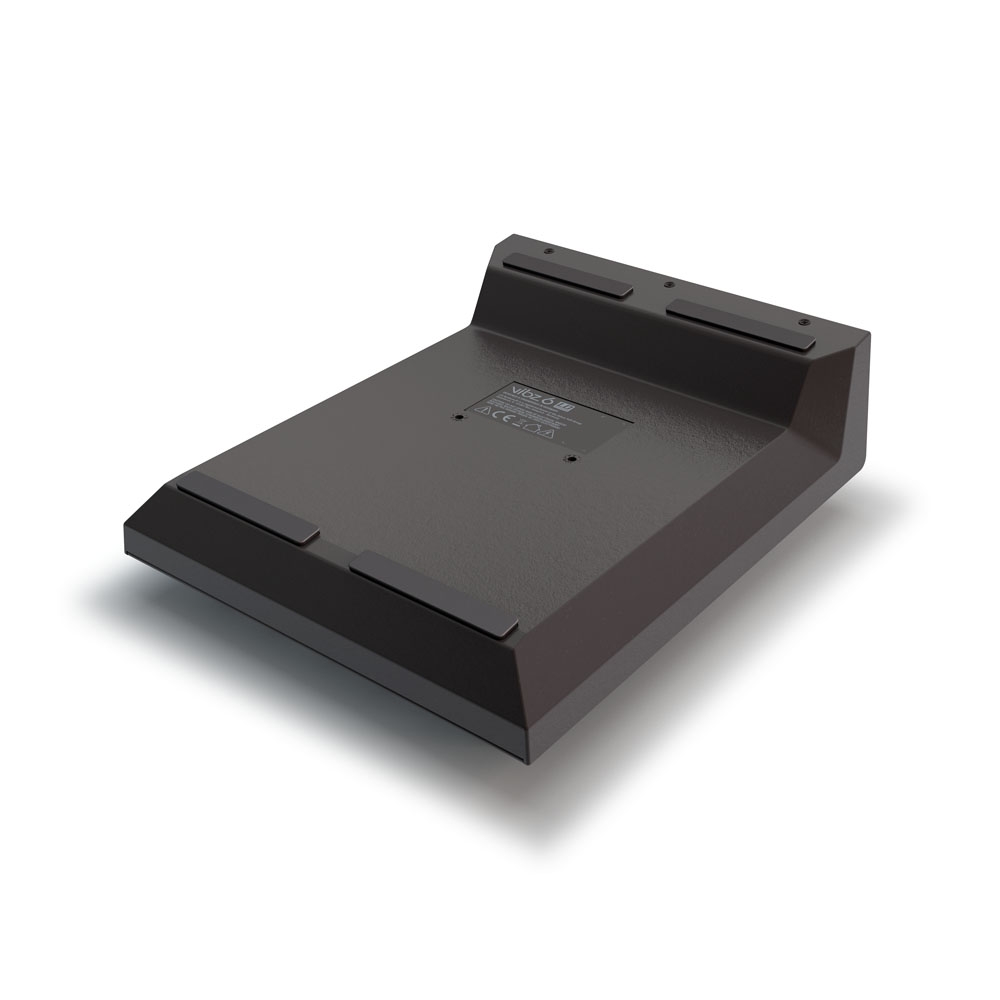| Content | User´s manual
IF Design Award 2016 certificate
Reddot Award 2016 certificate Data Sheet 39 KB
6 channel Mixing Console with DFX
6-channel mixer with 16 digital effects
2 microphone channels with 3-band EQ
2 mono-compatible stereo line channels with 2-band EQ
Master, Monitor and headphone outputs
Securely fastening external power supply
The VIBZ 6 D is a compact 6-channel mixer which is perfectly suited to entertainers, small bands, home recording and installations. It features two balanced microphone inputs with high quality preamps, phantom power and 3-band EQ with +/-15 dB adjustment scope, two stereo line inputs with 2-band EQ, which are mono-compatible, and an effects loop.
The master section of the VIBZ 6 D is equipped with adjustable monitor outputs, a headphone jack and 16 digital effects presets, which are foot-switchable. The mixer also has inputs and outputs for recording and playback devices, is extremely easy to use and offers a warm differentiated sound. The external power supply can be screwed on tightly.
A foot switch for the effects section and an adapter for mounting the VIBZ 6 D on microphone stands are available as accessories.
Product type
Mixers
Type
Live
Channels
6
Mono Channels:
Mono Mic and Line Input Channels
2
Mono Mic input connectors
6.3 mm TRS , XLR
Mono Mic Input Type
electronically balanced
Mono Mic Input Frequency Range
10 Hz
Amplification Range mono Mic Input
- 50 dB
Mono Mic Input Input THD-N
0.0058%
Mono Mic Input Impedance
4k Ohm(s)
Mono Line Input Type
electronically balanced
Mono Line Input Frequency Range
10 Hz
Amplification Range mono Line Input
- 50 dB
Mono Line Input Input THD-N
0.0045 %
Mono Line Input Impedance
21k Ohm(s)
Mono Line Input S/N Ratio
116 dB
Mono Channel Equalizer High
+/- 15 dB @ 12000 Hz
Mono Channel Equalizer Low
+/- 15 dB @ 80 Hz
Controls Mono Mic and Line Input Channels
3-band EQ (High, Mid, Low) , AUX (DFX) Post , Channel Volume , Gain , pan
Phantom power
48 V DC switchable
Stereo Channels:
Stereo Line Input Channels
2
Stereo Line Input Connectors
6.3 mm TS
Stereo Line Input Type
unbalanced
Stereo Line Input Frequency Range
10 - 54000 Hz
Stereo Line Input Input THD-N
0.0045 %
Stereo Line Input Impedance
3,7k Ohm(s)
Stereo Line Input S/N Ratio
116 dB
Stereo channel equalizer treble
+/- 15 dB @ 12000 Hz
Stereo channel equalizer bass
+/- 15 dB @ 80 Hz
Controls Stereo Line Input Channels
2-band EQ (High,Low) , AUX (DFX) Post , Balance , Channel Volume
Main Section:
AUX / Effects Send Channels
1
AUX / Effects Send Connectors
6.3 mm stereo jack unbalanced
Stereo AUX Return Channels
1 x stereo
Stereo AUX Return Connectors
2 x 6.3 mm TRS
Stereo Tape Out Channel
1 x stereo
Stereo Tape Out Connectors
2 x RCA (Cinch)
Stereo Tape In Channel
1 x stereo
Stereo Tape In Connenctors
2 x RCA (Cinch)
Unbalanced stereo Main Outputs
1
Unbalanced stereo Main Output Connections
6.3 mm TRS
Unbalanced Stereo Main Out Impedance
120 Ohm(s)
Max. Unbalanced Stereo Main Out Level
+20 dBu
Stereo Control Room Out
1
Stereo Control Room Out Connectors
6.3 mm stereo jack unbalanced
Headphones ouput
1
Headphones outputs
6.3 mm TRS
Digital Effects Processor
Yes, 24-bit AD/DA Resolution
Number of Presets
16
Footswitch Connector DFX Mute
6.3 mm TRS
Main section controls
2-track Assignment (Main, Contr. Room) , 2-track In Volume , DFX Mute Schalter , DFX Presets , DFX To Main Volume , Master Volume , Phantom Power , Phones / Control Room Volume , Stereo Return Volume
Indicators
4-segment Level Meter , Channel Peak , DFX Peak / Mute , Phantom Power , Power
Operating voltage
18 V AC - 1 A, External PSU
Width
209 mm
Height
68 mm
Depth
260 mm
Weight
1,45 kg |
MIC/LINE Input Channels
The XLR microphone input is equipped with an extremely high quality, ultra-low noise, discrete preamp.
The +48V phantom power for condenser microphones can be switched in groups of six.
The Line Input and Channel Insert are implemented as jack sockets.
The Gain can be controlled in the range 0-60 dB.
The switchable Lo Cut filter (80Hz, 18dB/oct.) serves to eliminate low-frequency noise. A very typical DYNACORD feature is the asymmetrical Voicing Filter by means of which, if desired, the voice can be powerfully emphasized in the mix.
Optimized for ease-of-use, the 3-band semi-parametric equalizer makes it possible even for unpracticed users to perform the requisite corrections swiftly and intuitively.
With their extended buss structures, the CMS3 mixers offer very flexible configuration options. In all, 6 AUX busses are available in each case:
2 (FX) are assiged to the two effects devices;
2 (AUX) can be configured either as monitor or effects sends by means of a switch in the Main section;
2 (MON) are designed as monitor sends, each being equipped with a sweepable anti-feedback filter in the Master section.
MUTE and PFL switches, each with its own LED, make it possible to mute each input channel individually and/or listen to its pre-fader signal.
Each channel offers a Signal Present and Peak LED for level control.
The channel faders are dust-protected and offer not only excellent crosstalk attenuation but also a practice-optimized control characteristic.
All potentiometers and faders are high-quality components from ALPS.
Stereo MIC/LINE Input Channels
The stereo input channels are equipped in much the same way, but optimized, naturally, to carry stereo signals.
Two of the four stereo inputs of each model are additionally equipped with cinch (RCA) sockets switched in parallel for CD or MP3 players.
The two other stereo inputs receive in addition the four channels of the digital audio interface USB 1-2 and USB 3-4
Separate Gain controls are provided for the Stereo Line and Mic inputs to permit them to be used in parallel if desired.
Three-band tone controls are provided, and a Balance control replaces the PAN control found in the mono channel strips.
MASTER
In the Master Section, too, the CMS3 mixers are lavishly equipped.
The 11-band stereo equalizer can be routed to the Master channels or else to either or both of the Monitor Sends according to choice.
The FX1+2 Returns as well as the AUX1+2 and MON1+2 Sends are on faders just like the Master L/R signal, which makes for comfortable and intuitive operation.
The Master B signal is available pre or post MASTER L/R fader and can be mono-summed if desired. The Master signal is also available on the REC Send cinch (RCA) output with level control.
The level meters of the CMS3 comprise two LED chains of 12 LEDs each. The display range covers 40 dB; what is shown is the level in dBu at the master outputs. When the PFL switch is activated, the left-hand LED chain shows the internal level of the master buss in dBu.
The Standby switch mutes all channels e.g. during pauses, with only the 2TRACK-to-Master input remaining active for the playback of interval music.
A 4-pin XLR socket is provided for the connection of a standard 12V/5W gooseneck lamp.
DIGITAL USB 2.0 AUDIO INTERFACE
The USB 2.0 port serves as a digital audio interface between the CMS3 and a PC or Mac. Four channels can be transmitted in either direction simultaneously. This interface can therefore be used either for the input of audio signals (e.g. for playback or interval music) or else for live- or studio-recording applications. It is configured by selecting the relevant setting in the menu.
For the use of the CMS3 with a PC or Mac, a free Cubase LE license as well as the requisite USB drivers are included free-of-charge on the supplied DVD.
PC MIDI Interface
The CMS3 also offers a fully-featured PC MIDI interface.
The MIDI input also supports the remote switching of both internal effects units using a master keyboard or MIDI footswitch.
Professional Effects, OLED Display and Processing Menus
The CMS3 has two integrated stereo multi-effects processors that work independently of one another, each offering 100 effects algorithms optimized for live performance, the most important parameters of which are editable.
Linear 24-bit AD/DA converters and 48-bit double-precision processing guarantee the finest studio quality based on state-of-the-art technology.
The 100 program locations of each device are packed with high-quality reverbs, halls and plates that deliver professional results in live performance on stage as well as in both studio and home recording environments.
Other presets include Echo/Reverb and Chorus/Echo combinations, a variety of delay, flanger, chorus and doubling algorithms, as well as special reverb and delay programs. When a delay effect is active, the delay time can be synchronized to the beat of the music using the TAP key.
Edited effects programs can be stored in the 20 User memories offered by each device, assigned names, and later selected and used in the same way as the presets.
The large, high-contrast OLED display is easily read from a wide range of viewing angles—even in very bright surroundings. The operation of the effects units and processing menus is intuitive and made easier still through the use of soft keys and a rotary encoder.
Processing Menus
For the basic settings, configuration, use of the effects and special functions, a wide variety of editing options can be selected from the clearly arranged menus.
Innovative Solution for Protection and Transportation
Optionally available for the CMS 1000 and 1600 is a very robust plastic lid with an integrated handle—a highly innovative solution that offers optimal protection for the device as well as greater carrying comfort.
For the CMS 2200, due to its greater size, a flight-case solution is recommended (available as a further option is a dust cover: the DC-PM2200-COVER).
Accessories
For rack installation of the CMS 1000 (or table installation of the models 1600 and 2200), the mounting kit RMK 1000-3 is available.
Other accessories include the gooseneck light DC-LITLITE-4P and the DC-FS11 ON/OFF footswitch for the effects units. | |
MIC/LINE Input Channels
The XLR microphone input is equipped with an extremely high quality, ultra-low noise, discrete preamp.
The +48V phantom power for condenser microphones can be switched in groups of six.
The Line Input and Channel Insert are implemented as jack sockets.
The Gain can be controlled in the range 0-60 dB.
The switchable Lo Cut filter (80Hz, 18dB/oct.) serves to eliminate low-frequency noise. A very typical DYNACORD feature is the asymmetrical Voicing Filter by means of which, if desired, the voice can be powerfully emphasized in the mix.
Optimized for ease-of-use, the 3-band semi-parametric equalizer makes it possible even for unpracticed users to perform the requisite corrections swiftly and intuitively.
With their extended buss structures, the CMS3 mixers offer very flexible configuration options. In all, 6 AUX busses are available in each case:
2 (FX) are assiged to the two effects devices;
2 (AUX) can be configured either as monitor or effects sends by means of a switch in the Main section;
2 (MON) are designed as monitor sends, each being equipped with a sweepable anti-feedback filter in the Master section.
MUTE and PFL switches, each with its own LED, make it possible to mute each input channel individually and/or listen to its pre-fader signal.
Each channel offers a Signal Present and Peak LED for level control.
The channel faders are dust-protected and offer not only excellent crosstalk attenuation but also a practice-optimized control characteristic.
All potentiometers and faders are high-quality components from ALPS.
Stereo MIC/LINE Input Channels
The stereo input channels are equipped in much the same way, but optimized, naturally, to carry stereo signals.
Two of the four stereo inputs of each model are additionally equipped with cinch (RCA) sockets switched in parallel for CD or MP3 players.
The two other stereo inputs receive in addition the four channels of the digital audio interface USB 1-2 and USB 3-4
Separate Gain controls are provided for the Stereo Line and Mic inputs to permit them to be used in parallel if desired.
Three-band tone controls are provided, and a Balance control replaces the PAN control found in the mono channel strips.
MASTER
In the Master Section, too, the CMS3 mixers are lavishly equipped.
The 11-band stereo equalizer can be routed to the Master channels or else to either or both of the Monitor Sends according to choice.
The FX1+2 Returns as well as the AUX1+2 and MON1+2 Sends are on faders just like the Master L/R signal, which makes for comfortable and intuitive operation.
The Master B signal is available pre or post MASTER L/R fader and can be mono-summed if desired. The Master signal is also available on the REC Send cinch (RCA) output with level control.
The level meters of the CMS3 comprise two LED chains of 12 LEDs each. The display range covers 40 dB; what is shown is the level in dBu at the master outputs. When the PFL switch is activated, the left-hand LED chain shows the internal level of the master buss in dBu.
The Standby switch mutes all channels e.g. during pauses, with only the 2TRACK-to-Master input remaining active for the playback of interval music.
A 4-pin XLR socket is provided for the connection of a standard 12V/5W gooseneck lamp.
DIGITAL USB 2.0 AUDIO INTERFACE
The USB 2.0 port serves as a digital audio interface between the CMS3 and a PC or Mac. Four channels can be transmitted in either direction simultaneously. This interface can therefore be used either for the input of audio signals (e.g. for playback or interval music) or else for live- or studio-recording applications. It is configured by selecting the relevant setting in the menu.
For the use of the CMS3 with a PC or Mac, a free Cubase LE license as well as the requisite USB drivers are included free-of-charge on the supplied DVD.
PC MIDI Interface
The CMS3 also offers a fully-featured PC MIDI interface.
The MIDI input also supports the remote switching of both internal effects units using a master keyboard or MIDI footswitch.
Professional Effects, OLED Display and Processing Menus
The CMS3 has two integrated stereo multi-effects processors that work independently of one another, each offering 100 effects algorithms optimized for live performance, the most important parameters of which are editable.
Linear 24-bit AD/DA converters and 48-bit double-precision processing guarantee the finest studio quality based on state-of-the-art technology.
The 100 program locations of each device are packed with high-quality reverbs, halls and plates that deliver professional results in live performance on stage as well as in both studio and home recording environments.
Other presets include Echo/Reverb and Chorus/Echo combinations, a variety of delay, flanger, chorus and doubling algorithms, as well as special reverb and delay programs. When a delay effect is active, the delay time can be synchronized to the beat of the music using the TAP key.
Edited effects programs can be stored in the 20 User memories offered by each device, assigned names, and later selected and used in the same way as the presets.
The large, high-contrast OLED display is easily read from a wide range of viewing angles—even in very bright surroundings. The operation of the effects units and processing menus is intuitive and made easier still through the use of soft keys and a rotary encoder.
Processing Menus
For the basic settings, configuration, use of the effects and special functions, a wide variety of editing options can be selected from the clearly arranged menus.
Innovative Solution for Protection and Transportation
Optionally available for the CMS 1000 and 1600 is a very robust plastic lid with an integrated handle—a highly innovative solution that offers optimal protection for the device as well as greater carrying comfort.
For the CMS 2200, due to its greater size, a flight-case solution is recommended (available as a further option is a dust cover: the DC-PM2200-COVER).
Accessories
For rack installation of the CMS 1000 (or table installation of the models 1600 and 2200), the mounting kit RMK 1000-3 is available.
Other accessories include the gooseneck light DC-LITLITE-4P and the DC-FS11 ON/OFF footswitch for the effects units. | |
MIC/LINE Input Channels
The XLR microphone input is equipped with an extremely high quality, ultra-low noise, discrete preamp.
The +48V phantom power for condenser microphones can be switched in groups of six.
The Line Input and Channel Insert are implemented as jack sockets.
The Gain can be controlled in the range 0-60 dB.
The switchable Lo Cut filter (80Hz, 18dB/oct.) serves to eliminate low-frequency noise. A very typical DYNACORD feature is the asymmetrical Voicing Filter by means of which, if desired, the voice can be powerfully emphasized in the mix.
Optimized for ease-of-use, the 3-band semi-parametric equalizer makes it possible even for unpracticed users to perform the requisite corrections swiftly and intuitively.
With their extended buss structures, the CMS3 mixers offer very flexible configuration options. In all, 6 AUX busses are available in each case:
2 (FX) are assiged to the two effects devices;
2 (AUX) can be configured either as monitor or effects sends by means of a switch in the Main section;
2 (MON) are designed as monitor sends, each being equipped with a sweepable anti-feedback filter in the Master section.
MUTE and PFL switches, each with its own LED, make it possible to mute each input channel individually and/or listen to its pre-fader signal.
Each channel offers a Signal Present and Peak LED for level control.
The channel faders are dust-protected and offer not only excellent crosstalk attenuation but also a practice-optimized control characteristic.
All potentiometers and faders are high-quality components from ALPS.
Stereo MIC/LINE Input Channels
The stereo input channels are equipped in much the same way, but optimized, naturally, to carry stereo signals.
Two of the four stereo inputs of each model are additionally equipped with cinch (RCA) sockets switched in parallel for CD or MP3 players.
The two other stereo inputs receive in addition the four channels of the digital audio interface USB 1-2 and USB 3-4
Separate Gain controls are provided for the Stereo Line and Mic inputs to permit them to be used in parallel if desired.
Three-band tone controls are provided, and a Balance control replaces the PAN control found in the mono channel strips.
MASTER
In the Master Section, too, the CMS3 mixers are lavishly equipped.
The 11-band stereo equalizer can be routed to the Master channels or else to either or both of the Monitor Sends according to choice.
The FX1+2 Returns as well as the AUX1+2 and MON1+2 Sends are on faders just like the Master L/R signal, which makes for comfortable and intuitive operation.
The Master B signal is available pre or post MASTER L/R fader and can be mono-summed if desired. The Master signal is also available on the REC Send cinch (RCA) output with level control.
The level meters of the CMS3 comprise two LED chains of 12 LEDs each. The display range covers 40 dB; what is shown is the level in dBu at the master outputs. When the PFL switch is activated, the left-hand LED chain shows the internal level of the master buss in dBu.
The Standby switch mutes all channels e.g. during pauses, with only the 2TRACK-to-Master input remaining active for the playback of interval music.
A 4-pin XLR socket is provided for the connection of a standard 12V/5W gooseneck lamp.
DIGITAL USB 2.0 AUDIO INTERFACE
The USB 2.0 port serves as a digital audio interface between the CMS3 and a PC or Mac. Four channels can be transmitted in either direction simultaneously. This interface can therefore be used either for the input of audio signals (e.g. for playback or interval music) or else for live- or studio-recording applications. It is configured by selecting the relevant setting in the menu.
For the use of the CMS3 with a PC or Mac, a free Cubase LE license as well as the requisite USB drivers are included free-of-charge on the supplied DVD.
PC MIDI Interface
The CMS3 also offers a fully-featured PC MIDI interface.
The MIDI input also supports the remote switching of both internal effects units using a master keyboard or MIDI footswitch.
Professional Effects, OLED Display and Processing Menus
The CMS3 has two integrated stereo multi-effects processors that work independently of one another, each offering 100 effects algorithms optimized for live performance, the most important parameters of which are editable.
Linear 24-bit AD/DA converters and 48-bit double-precision processing guarantee the finest studio quality based on state-of-the-art technology.
The 100 program locations of each device are packed with high-quality reverbs, halls and plates that deliver professional results in live performance on stage as well as in both studio and home recording environments.
Other presets include Echo/Reverb and Chorus/Echo combinations, a variety of delay, flanger, chorus and doubling algorithms, as well as special reverb and delay programs. When a delay effect is active, the delay time can be synchronized to the beat of the music using the TAP key.
Edited effects programs can be stored in the 20 User memories offered by each device, assigned names, and later selected and used in the same way as the presets.
The large, high-contrast OLED display is easily read from a wide range of viewing angles—even in very bright surroundings. The operation of the effects units and processing menus is intuitive and made easier still through the use of soft keys and a rotary encoder.
Processing Menus
For the basic settings, configuration, use of the effects and special functions, a wide variety of editing options can be selected from the clearly arranged menus.
Innovative Solution for Protection and Transportation
Optionally available for the CMS 1000 and 1600 is a very robust plastic lid with an integrated handle—a highly innovative solution that offers optimal protection for the device as well as greater carrying comfort.
For the CMS 2200, due to its greater size, a flight-case solution is recommended (available as a further option is a dust cover: the DC-PM2200-COVER).
Accessories
For rack installation of the CMS 1000 (or table installation of the models 1600 and 2200), the mounting kit RMK 1000-3 is available.
Other accessories include the gooseneck light DC-LITLITE-4P and the DC-FS11 ON/OFF footswitch for the effects units. |





















Reviews
There are no reviews yet.